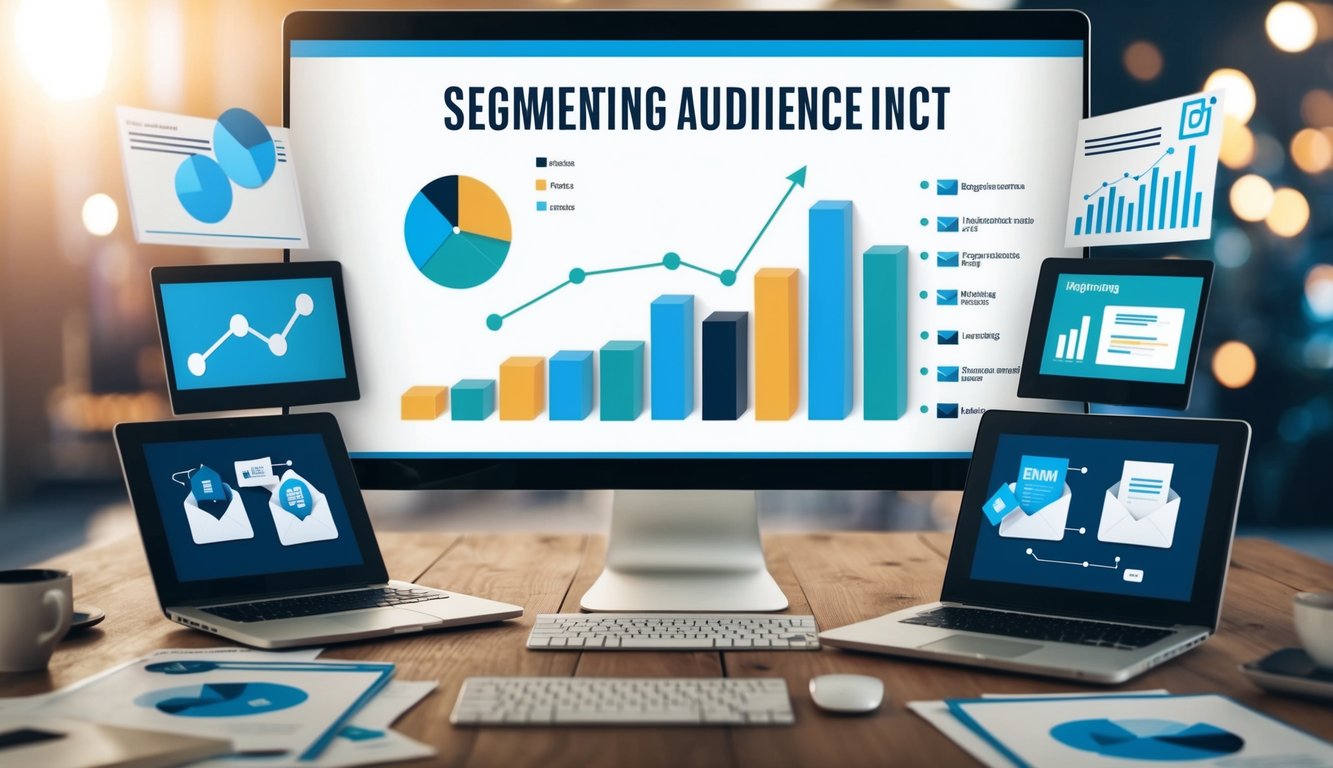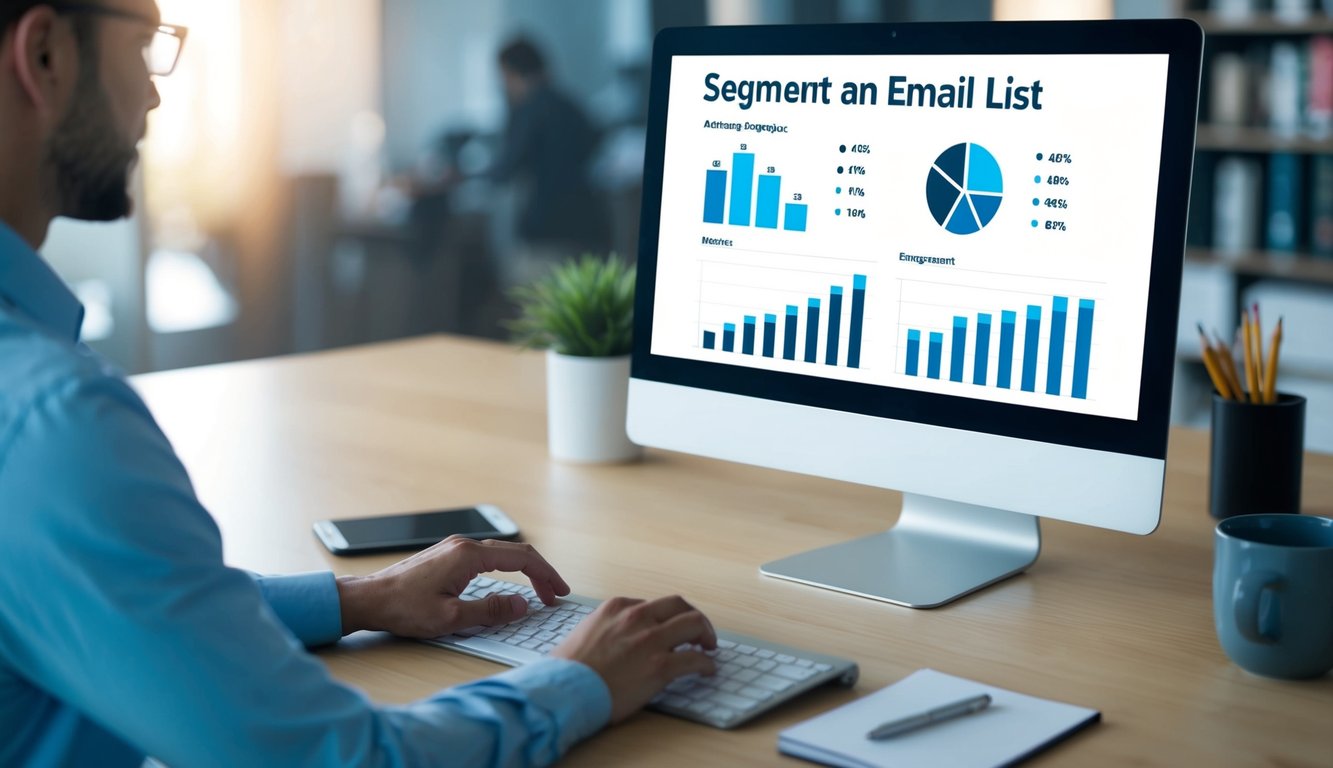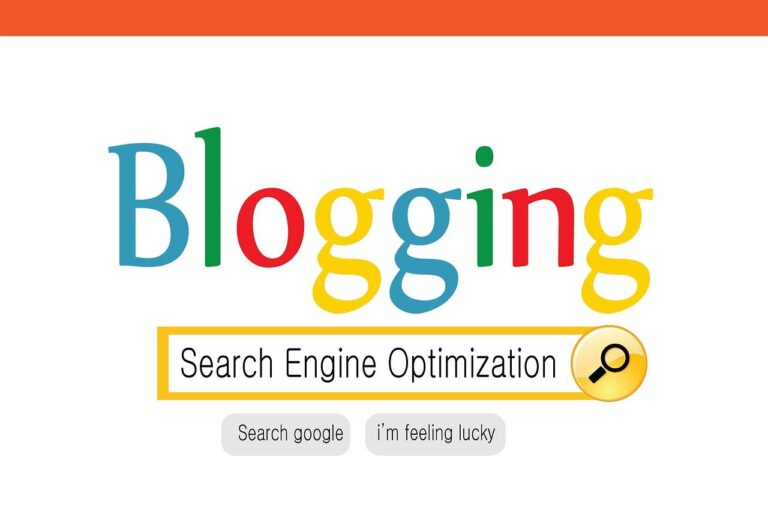Email marketing remains a powerful tool for businesses, but sending the same message to everyone yields lackluster results.
By segmenting your audience, you can craft personalized campaigns that resonate with specific groups, leading to higher engagement and conversions.

Effective email segmentation involves dividing your subscriber list based on relevant criteria such as demographics, behavior, or preferences.
This approach allows you to tailor your content, offers, and messaging to match the unique needs and interests of each segment. For example, you might create separate campaigns for new sign-ups versus loyal customers, ensuring each group receives information most relevant to them.
Implementing segmentation doesn’t have to be complex.
Start with basic criteria like purchase history or geographic location, and gradually refine your approach as you gather more data about your subscribers.
With the right strategies and tools, you can transform your email marketing from a one-size-fits-all approach to a targeted, personalized experience that drives results.
Key Takeaways
- Segmentation tailors email content to specific audience groups, boosting engagement and conversions
- Start with basic segmentation criteria and refine your approach over time
- Measure campaign performance for each segment to continuously optimize your strategy
Understanding The Importance Of Email Segmentation
Email segmentation allows you to tailor your messages to specific groups within your audience, enhancing relevance and effectiveness.
By dividing your list based on key criteria, you can create more targeted and impactful campaigns.
Benefits Of Segmentation For Holistic Health Practices
Segmentation enables holistic health practices to deliver personalized content to clients based on their unique needs and interests. You can group clients by health concerns, treatment preferences, or wellness goals.
This targeted approach increases the likelihood of engagement and conversions. For example, you might send:
- Meditation tips to stress management clients
- Nutrition advice to those seeking weight loss
- Herbal remedy information to natural healing enthusiasts
By addressing specific concerns, you demonstrate expertise and build trust with your audience. This personalized touch can lead to higher open rates, click-throughs, and ultimately, more bookings for your practice.
How Segmentation Improves Client Engagement
Segmenting your email list allows you to craft messages that resonate with each group’s interests and behaviors. This targeted approach can significantly boost client engagement and loyalty.
You can segment based on:
- Past purchases or services used
- Frequency of visits
- Preferred communication methods
- Engagement levels with previous emails
By tailoring your content, you show clients that you understand and value their individual needs. This personalization can lead to higher open rates and more meaningful interactions.
For example, you might send follow-up care instructions to recent clients, while offering special promotions to those who haven’t visited in a while. This strategy helps maintain relationships with active clients and re-engage those who may have fallen off your radar.
Key Strategies For Segmenting Your Email List
Effective email list segmentation enhances campaign performance and engagement. By dividing your audience into specific groups, you can deliver more relevant content that resonates with each segment.
Demographic Segmentation
Demographic segmentation involves categorizing subscribers based on personal characteristics. Common demographic factors include:
- Age
- Gender
- Location
- Income level
- Education
- Occupation
This approach allows you to tailor your messaging to different age groups or target specific locations with region-specific offers.
For example, you might send different product recommendations to millennials versus baby boomers, or customize promotions based on local events in different cities.
Behavioral Segmentation
Behavioral segmentation focuses on how subscribers interact with your emails and website. Key behavioral factors to consider:
- Past purchases
- Email engagement (open rates, click-through rates)
- Website activity
- Cart abandonment
By analyzing these behaviors, you can create highly targeted campaigns. For instance, send re-engagement emails to inactive subscribers or personalized product recommendations based on browsing history.
You can also set up automated workflows to trigger emails based on specific actions, such as a welcome series for new subscribers or a follow-up email after a purchase.
Interest-Based Segmentation
Interest-based segmentation divides your list according to subscribers’ preferences and interests. To implement this strategy:
- Survey your subscribers about their preferences
- Track which types of content they engage with most
- Analyze their purchase history for patterns
Create segments based on product categories, content topics, or brand preferences. This allows you to send highly relevant content that aligns with each group’s interests.
For example, a clothing retailer might segment their list into those interested in men’s fashion, women’s accessories, or children’s clothing, ensuring each group receives tailored product recommendations and content.
Tools And Techniques For Effective Segmentation
Effective email segmentation requires the right tools and techniques to divide your audience into meaningful groups. By leveraging technology and data analysis, you can create targeted campaigns that resonate with specific subscriber segments.
Using Email Marketing Platforms
Email marketing platforms offer built-in segmentation features to help you categorize your subscribers. These tools allow you to create segments based on various criteria such as demographics, behavior, and engagement levels.
Look for platforms that provide:
- Drag-and-drop segment builders
- Pre-built segment templates
- Integration with your CRM system
- Real-time segmentation updates
Advanced platforms may offer AI-powered segmentation, automatically grouping subscribers based on patterns and similarities. This can save you time and uncover insights you might have missed.
Collecting And Analyzing Subscriber Data
To segment effectively, you need comprehensive subscriber data. Implement strategies to gather relevant information:
- Use sign-up forms to collect basic demographic data
- Track website behavior and purchase history
- Conduct surveys to learn more about preferences and interests
- Monitor email engagement metrics like open rates and click-throughs
Analyze this data to identify patterns and trends that can inform your segmentation strategy. Look for commonalities among high-value customers or those most likely to convert.
Utilize data visualization tools to help spot trends and relationships in your subscriber data. This can guide your segmentation decisions and reveal opportunities for more targeted campaigns.
Implementing Tags And Custom Fields
Tags and custom fields allow you to add specific attributes to subscriber profiles, enabling more granular segmentation. Use these features to:
- Categorize subscribers based on interests or preferences
- Track participation in specific campaigns or events
- Note customer lifecycle stages
Create a tagging system that aligns with your business goals and customer attributes. For example, you might use tags like “VIP customer,” “product interest: shoes,” or “webinar attendee.”
Set up automated workflows to apply tags based on subscriber actions. This ensures your segments stay up-to-date without manual intervention. Regularly review and refine your tagging system to maintain its relevance and effectiveness.
Creating Targeted Campaigns For Different Segments

Effective audience segmentation allows you to craft personalized email campaigns that resonate with specific groups. By tailoring your content, timing, and approach, you can significantly boost engagement and conversion rates.
Personalized Content Strategies
To create impactful targeted campaigns, focus on customizing your message for each segment.
Start by analyzing your audience data to understand their preferences, behaviors, and needs.
Use this information to develop unique value propositions for each group. For example, offer exclusive discounts to price-sensitive customers or highlight premium features for high-value clients.
Incorporate dynamic content blocks in your emails to automatically display relevant information based on subscriber attributes. This could include personalized product recommendations, location-specific offers, or industry-tailored solutions.
Test different subject lines, email layouts, and call-to-action buttons for each segment to optimize engagement. Remember to maintain brand consistency while adapting your tone and style to suit each group’s preferences.
Timing And Frequency Adjustments
Optimal email timing and frequency can vary significantly between segments. Analyze your data to identify when each group is most likely to engage with your emails.
Consider factors such as:
- Time zones
- Work schedules
- Purchase history
- Engagement patterns
Use automation tools to schedule emails at the best times for each segment. This might mean sending promotional emails on weekends for leisure-focused customers or early mornings for busy professionals.
Adjust your sending frequency based on segment preferences. Some groups may welcome daily updates, while others prefer weekly or monthly communications. Implement preference centers to allow subscribers to choose their desired frequency.
Monitor engagement metrics closely and adjust your strategy accordingly. If you notice declining open rates, consider reducing frequency or refreshing your content approach.
Case Studies Of Successful Campaigns
Examining real-world examples can provide valuable insights for your own segmentation efforts. Consider the following case studies:
-
E-commerce retailer: By segmenting customers based on past purchases and browsing behavior, they increased email revenue by 150% through personalized product recommendations.
-
B2B software company: Tailoring content to different industry verticals and job roles resulted in a 40% boost in demo requests from email campaigns.
-
Travel agency: Segmenting by destination preferences and travel frequency led to a 25% increase in booking rates from targeted promotional emails.
These examples demonstrate the power of well-executed segmentation strategies. Key takeaways include the importance of data-driven decision-making, continuous testing, and adapting your approach based on segment-specific insights.
Measuring And Optimizing Your Segmentation Efforts

Tracking key metrics, conducting A/B tests, and adjusting strategies are essential for maximizing the impact of your email segmentation efforts. These practices allow you to refine your approach and deliver more targeted, effective campaigns.
Key Metrics To Track
Start by monitoring open rates and click-through rates (CTRs) for each segment. These metrics provide insights into engagement levels and content relevance.
Track conversion rates to measure how effectively your segmented emails drive desired actions. This could include purchases, sign-ups, or downloads.
Pay attention to unsubscribe rates and spam complaints. High rates may indicate poorly targeted content or over-communication with certain segments.
Revenue per email is crucial for evaluating the financial impact of your segmentation efforts. Calculate this by dividing total revenue generated from a campaign by the number of emails sent.
List growth rate helps you assess the health of your email list. Monitor how quickly each segment is expanding or contracting over time.
A/B Testing For Continuous Improvement
Regularly conduct A/B tests to optimize your segmented campaigns. Test different subject lines, email content, and calls-to-action for each segment.
Experiment with send times to determine when each segment is most likely to engage with your emails. This can significantly impact open and click-through rates.
Try varying email designs and layouts. Some segments may respond better to image-heavy emails, while others prefer text-based content.
Test personalization techniques, such as using the recipient’s name or referencing past purchases. Measure how these affect engagement across different segments.
Evaluate the effectiveness of different offers or promotions for each segment. This can help you tailor future campaigns more effectively.
Adjusting Segmentation Strategies Based On Results
Regularly review your segment definitions and criteria. As you gather more data, you may identify new patterns or characteristics that warrant adjusting your segments.
Consider combining underperforming segments or splitting high-performing ones for more targeted messaging. This can help you refine your approach and improve overall results.
Analyze which types of content resonate best with each segment. Use these insights to inform future content creation and email marketing strategies.
Pay attention to segment overlap. If you find significant overlap between segments, you may need to refine your criteria for more distinct groupings.
Be prepared to create new segments as you identify emerging trends or customer behaviors. This flexibility allows you to stay responsive to changing market dynamics.
Common Challenges And How To Overcome Them

Effective audience segmentation faces several hurdles that can impact your email campaign success. By addressing these challenges head-on, you can improve your targeting and achieve better results from your marketing efforts.
Dealing With Incomplete Data
Incomplete data can severely hamper your segmentation efforts. To overcome this, start by identifying gaps in your customer information.
Implement progressive profiling techniques to gradually collect more data over time. Use surveys, quizzes, and interactive content to encourage customers to share additional details.
Consider leveraging third-party data sources to supplement your existing information. Implement data cleansing processes to remove outdated or inaccurate entries. Regularly update your database to ensure it remains current and relevant.
Focus on collecting the most critical data points first. Prioritize information that directly impacts your segmentation strategy, such as purchase history, browsing behavior, and preferences.
Avoiding Over-Segmentation
While segmentation is valuable, over-segmentation can lead to ineffective campaigns. To avoid this, start with broad segments and refine them based on performance data.
Use A/B testing to compare the effectiveness of different segmentation approaches. Set a minimum segment size to ensure statistical significance.
Combine similar micro-segments if they share key characteristics or behaviors. Regularly review and consolidate your segments to maintain efficiency.
Focus on actionable segments that align with your business goals. Avoid creating segments based on trivial differences that don’t significantly impact marketing outcomes.
Ensuring Privacy And Compliance
Protecting customer data and complying with regulations is crucial for ethical segmentation. Familiarize yourself with relevant laws like GDPR and CCPA.
Implement robust data protection measures, including encryption and access controls. Be transparent about your data collection and usage practices.
Provide clear opt-in and opt-out mechanisms for your email campaigns. Regularly audit your data handling processes to ensure ongoing compliance.
Consider using anonymized or aggregated data for segmentation where possible. Train your team on privacy best practices and the importance of data protection. Stay informed about evolving regulations to adapt your strategies accordingly.
Conclusion

Tailoring your email campaigns through audience segmentation is crucial for achieving maximum impact. By dividing your subscribers into specific groups, you can deliver more relevant content that resonates with their unique needs and interests.
Personalized campaigns based on demographics, behavior, or location can significantly boost engagement and conversion rates. This targeted approach helps you build stronger relationships with your audience.
Remember to continually analyze and refine your segmentation strategies. Use data-driven insights to adjust your approach and improve results over time.
Implementing email segmentation may require some initial effort, but the benefits far outweigh the costs. You’ll see improved open rates, click-through rates, and ultimately, better ROI for your email marketing campaigns.
Start small if you’re new to segmentation. Begin with basic criteria and gradually expand as you become more comfortable with the process. Keep testing and optimizing to find what works best for your specific audience.
By embracing audience segmentation, you’ll transform your email marketing from a one-size-fits-all approach to a powerful, personalized communication tool that drives real results for your business.
Frequently Asked Questions

Email segmentation enhances campaign effectiveness through tailored messaging. It allows for personalized content delivery based on subscriber characteristics and behaviors. Proper segmentation leads to higher engagement rates and improved conversions.
What are the advantages of segmenting email campaign audiences?
Segmenting email audiences allows for more targeted and relevant messaging. You can tailor content to specific groups based on their interests, behaviors, or demographics.
Audience segmentation significantly enhances marketing effectiveness. It improves open rates, click-through rates, and overall engagement.
Segmentation also reduces unsubscribe rates by ensuring subscribers receive content they find valuable and interesting.
How can segmentation tools improve email campaign performance?
Segmentation tools automate the process of dividing your audience into distinct groups. They analyze subscriber data to create meaningful segments based on various criteria.
These tools can track engagement metrics and adjust segments dynamically. This ensures your campaigns remain relevant as subscriber behaviors change over time.
Advanced segmentation tools can identify patterns and preferences you might miss manually, leading to more effective targeting.
Can you provide examples of effective email segmentation?
Geographic segmentation can tailor product recommendations based on local weather or events. For instance, promoting winter coats to subscribers in colder regions.
Behavioral segmentation might target frequent shoppers with exclusive offers or early access to sales.
Technographic segmentation allows you to customize messaging based on the devices or platforms your subscribers use.
What is the impact of personalization in email marketing?
Personalization goes beyond using a subscriber’s name. It involves tailoring the entire email content to individual preferences and behaviors.
Personalized emails have higher open rates and click-through rates compared to generic messages. They create a sense of relevance and value for the recipient.
Personalization can significantly improve engagement and conversions in your email campaigns.
How should you approach segmenting a large email audience for tailored communication?
Start with basic segments based on easily accessible data like demographics or purchase history. Gradually refine your segments as you gather more data.
Use automation tools to manage and update segments efficiently. This ensures your segmentation remains accurate as your audience grows.
Focus on gathering quality data to inform your segmentation strategy. Prioritize data points that are most relevant to your business goals.
What key principles guide the segmentation of audiences in email marketing?
Relevance is crucial. Ensure each segment receives content that aligns with their interests and needs.
Consistency in messaging across segments maintains brand identity while allowing for personalization.
Regular analysis and adjustment of segments is essential. Subscriber behaviors and preferences change over time, so your segments should evolve accordingly.






